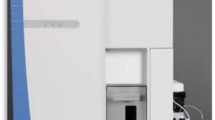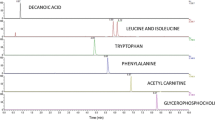Abstract
As an important regulatory factor in the process of embryo culture, amino acids are necessary components of in vitro fertilization medium (IVFM). The accurate determination of their content is of great significance to assisted reproductive technology (ART). The determination of 20 amino acids in IVFM samples with easy pre-treatment is established using the high-performance liquid chromatography–tandem mass spectrometry (HPLC–MS/MS) method. Chromatographic separation is achieved on a pentafluorophenyl column (150 mm × 2.1 um × 3 um) in a gradient elution mode with acetonitrile and water (both containing 0.1% formic acid) as the mobile phase at a flow rate of 0.2 mL/min. The column temperature is maintained at 40 ℃. All targets are resolved and identified based on the precursor ion, product ion, and retention time in a 12 min run time. The method is evaluated by linearity, limit of detection (LODs), limit of quantitation (LOQs), reproducibility, and precision according to the Chinese pharmacopeia based on the optimized conditions. The results demonstrate that the linear relationships of 20 amino acids are kept in the range of 0.1–2.0 mg/L with a correlation coefficient r ≥ 0.996. The LODs and LOQs are in the range of 0.83–66.67 and 2.76–222.22 ug/L, respectively. Recoveries (n = 3) of 95.9 – 118.8% are obtained at spiking of 0.4, 1.0 and 2.0 mg/L in quality control samples. Intra-day relative standard deviation (RSD) of these spiked samples is in the range of 0.03–6.82% with average relative error (RE) ranging from 0.35% to 18.07%, and the inter-day accuracy and precision results are within the acceptable range (RE ≤ 16.36%, RSD ≤ 11.25%). The proposed method is applied to test the real IVFM samples, and the measured values are within the labeled range, demonstrating its suitability for the quantification of amino acids in IVFM.





Similar content being viewed by others
References
Quinn P (2004) The development and impact of culture media for assisted reproductive technologies. Fertil Steril 81:27–29
Guidelines for the review of registration techniques, including soft contact lenses and liquid for human in vitro assisted reproductive technology. https://www.nmpa.gov.cn/xxgk/ggtg/qtggtg/20180426172301719.html, 4/25/2018. Accessed 26 April 2018.
Brison DR, Houghton FD, Falconer D, Roberts SA, Hawkhead J, Humpherson PG, Lieberman BA, Leese HJ (2004) Identification of viable embryos in IVF by non-invasive measurement of amino acid turnover. Hum Reprod 19:2319–2334
Ojha KS, Granato D, Rajuria G, Barba FJ, Kerry JP, Tiwari BK (2017) Application of chemometrics to assess the influence of ultrasound frequency, Lactobacillus sakei culture and drying on beef jerky manufacture: Impact on amino acid profile, organic acids, texture and colour. Food Chem 239:544–550
Zeng YH, Cai WS, Shao XG (2015) Quantitative analysis of 17 amino acids in tobacco leaves using an amino acid analyzer and chemometric resolution. J Sep Sci 38:2053–2058
Lamp A, Kaltschmitt M, Luedtke O (2018) Improved HPLC-method for estimation and correction of amino acid losses during hydrolysis of unknown samples. Anal Biochem 543:140–145
Olga R, Peter D, Mikhail K, Victoriya M, Olga U (2018) Development of a hydrophilic interaction high-performance liquid chromatography method for the determination of glycine in formulations of therapeutic immunoglobulins. Anal Bioanal Chem 410:6935–6942
Weatherly CA, Du S, Parpia C, Santos PT, Hartman AL, Armstrong DW (2017) d-amino acid levels in perfused mouse brain tissue and blood: a comparative study. ACS Chem Neurosci 8:1251–1261
Hernandez-Ferrer J, Teresa M, Maria M, Aida E, Alberto B (2015) Graphene oxide nanoribbon-based sensors for the simultaneous bio-electrochemical enantiomeric resolution and analysis of amino acid biomarkers. Biosens Bioelectron 68:163–167
Bi Q, Dong SQ, Sun YM, Lu XQ, Zhao L (2016) An electrochemical sensor based on cellulose nanocrystal for the enantioselective discrimination of chiral amino acids. Anal Biochem 508:50–57
Zhang LJ, Wang GH, Xiong C, Zheng L, He JB, Ding YS, Lu HB, Zhang GB, Cho K, Qiu LZ (2018) Chirality detection of amino acid enantiomers by organic electrochemical transistor. Biosens Bioelectron 105:121–128
Wang W, Ma LH, Yao FZ, Lin XL, Xu KX (2015) High-speed separation and detection of amino acids in laver using a short capillary electrophoresis system. Electrophoresis 36(2):335–340
Prior A, Moldovan RC, Crommen J, Servais AC, Fillet M, de Jong GJ, Somsen GW (2016) Enantioselective capillary electrophoresismass spectrometry of amino acids in cerebrospinal fluid using a chiral derivatizing agent and volatile surfactant. Anal Chim Acta 940:150–158
Reddy BS, Chary VN, Pavankumar P, Prabhakar S (2016) Characterization of N-methylated amino acids by GC-MS after ethyl chloroformate derivatization. J Mass Spectrom 51(8):638–650
Okahashi N, Kawana S, Iida J, Shimizu H, Matsuda F (2016) GC-MS/MS survey of collision-induced dissociation of tert-butyldimethylsilyl-derivatized amino acids and its application to 13C-metabolic flux analysis of Escherichia coli central metabolism. Anal Bioanal Chem 408(22):6133–6140
Liu M, Zhang X, Tan TW (2016) The effect of amino acids on lipid production and nutrient removal by Rhodotorula glutinis cultivation in starch wastewater. Biores Technol 218:712–717
Fujihara A, Maeda N (2017) Quantitative chiral analysis of amino acids in solution using enantiomer-selective photo dissociation of cold gas-phase tryptophan via chiral recognition. Anal Chim Acta 979:31–35
Han ML, Xie MY, Han J, Yuan DY, Yang T, Xie Y (2018) Development and validation of a rapid, selective, and sensitive LC-MS/MS method for simultaneous determination of d- and l-amino acids in human serum: application to the study of hepatocellular carcinoma. Anal Bioanal Chem 410(10):2517–2531
Li Z, Xing YP, Guo XJ, Cui Y (2017) Development of an UPLC-MS/MS method for simultaneous quantitation of 11 d-amino acids in different regions of rat brain: application to a study on the associations of d-amino acid concentration changes and Alzheimer’s disease. J Chromatogr B 1058:40–46
Kruve A, Rebane R, Kipper K, Oldekop ML, Evard H, Herodes K, Ravio P, Leito I (2015) Tutorial review on validation of liquid chromatography–mass spectrometry methods: part I. Anal Chim Acta 870:29–44
Kruve A, Rebane R, Kipper K, Oldekop ML, Evard H, Herodes K, Ravio P, Leito I (2015) Tutorial review on validation of liquid chromatography–mass spectrometry methods: part II. Anal Chim Acta 870:8–28
Zhang H, Liu C, Hua WY, Ghislain LP, Liu JH, Aschenbrenner L, Noell S, Dirico K, Lanyon LF, Steppan CM, Arnold DW, Covey TR, Datwani SS, Troutman MD (2021) Acoustic ejection mass spectrometry for high-throughput analysis. Anal Chem 93(31):10850–10861
Ferrer C, Lozano A, Agüera A, Girón AJ, Fernández-Alba AR (2011) Overcoming matrix effects using the dilution approach in multiresidue methods for fruits and vegetables. J Chromatogr A 1218:7634–7639
Funding
No funding was received for conducting this study.
Author information
Authors and Affiliations
Corresponding author
Ethics declarations
Competing Interests
The authors declare that they have no conflict of interest.
Human and Animal Rights
This article does not contain any studies with human or animal subjects performed by any of the authors.
Additional information
Publisher's Note
Springer Nature remains neutral with regard to jurisdictional claims in published maps and institutional affiliations.
Rights and permissions
About this article
Cite this article
Qin, Sj., Zheng, Gc., Li, F. et al. Simultaneous Determination of Twenty Amino Acids in In Vitro Fertilization Medium by the HPLC–MS/MS Method. Chromatographia 85, 643–654 (2022). https://doi.org/10.1007/s10337-022-04169-5
Received:
Revised:
Accepted:
Published:
Issue Date:
DOI: https://doi.org/10.1007/s10337-022-04169-5




